 publications
publications
Selected recent publications in reversed chronological order.
2025
-
 Griffiths phases in structurally disordered CeRhSn: Experimental evidence and theoretical modelingA. Ślebarski, and M. M. MaśkaPhys. Rev. B, Jun 2025
Griffiths phases in structurally disordered CeRhSn: Experimental evidence and theoretical modelingA. Ślebarski, and M. M. MaśkaPhys. Rev. B, Jun 2025Our report paves the way for insight into a structural disorder and its impact on the physical properties of strongly correlated electron systems (SCESs). In a critical regime, each perturbation, e.g., disorder due to structural defects or doping, can have a significant effect on the nature of the quantum macrostate of these materials. For a select group of SCESs, we have empirically documented the Griffiths singularity, as exemplified by CeRhSn, which exhibits non-Fermi-liquid characteristics in susceptibility and specific heat. Our numerical analysis has supported the Griffiths phase scenario for CeRhSn and has revealed that its dc magnetic susceptibility is strongly dependent on the size of inhomogeneous magnetic particles that form in these materials. In the presence of strong disorder, we have proposed a magnetic phase diagram for CeRhSn. The classical Griffiths phase has been identified in the temperature range below the onset temperature of 𝑇𝐺∼220K, while the quantum Griffiths phase with non-Fermi-liquid behavior emerges below the quantum critical temperature of 𝑇𝑄∼6K. The phase diagram developed in this study bears notable similarities to the scenario previously proposed by Vojta for magnetic quantum phase transitions in disordered metals.
@article{Griffiths2025, title = {Griffiths phases in structurally disordered CeRhSn: Experimental evidence and theoretical modeling}, author = {Ślebarski, A. and Maśka, M. M.}, journal = {Phys. Rev. B}, volume = {111}, issue = {23}, pages = {235106}, numpages = {10}, year = {2025}, month = jun, publisher = {American Physical Society}, doi = {10.1103/PhysRevB.111.235106}, url = {https://link.aps.org/doi/10.1103/PhysRevB.111.235106}, }
2024
-
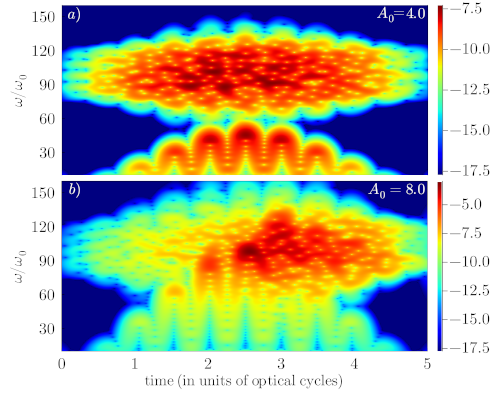 High Harmonic Tracking of Ultrafast Electron Dynamics across the Mott to Charge Density Wave Phase TransitionMarlena Dziurawiec, Jessica O. Almeida, Mohit Lal Bera, and 6 more authorsApr 2024
High Harmonic Tracking of Ultrafast Electron Dynamics across the Mott to Charge Density Wave Phase TransitionMarlena Dziurawiec, Jessica O. Almeida, Mohit Lal Bera, and 6 more authorsApr 2024Different insulator phases compete with each other in strongly correlated materials with simultaneous local and non-local interactions. It is known that the homogeneous Mott insulator converts into a charge density wave (CDW) phase when the non-local interactions are increased, but there is ongoing debate on whether and in which parameter regimes this transition is of first order, or of second order with an intermediate bond-order wave phase. Here we show that strong-field optics applied to an extended Fermi-Hubbard system can serve as a powerful tool to reveal the nature of the quantum phase transition. Specifically, we show that in the strongly interacting regime characteristic excitations such as excitons, biexcitons, excitonic strings, and charge droplets can be tracked by the non-linear optical response to an ultrafast and intense laser pulse. Subcycle analysis of high harmonic spectra unravels the ultrafast dynamics of these increasingly complex objects, which partially escape the scrutiny of linear optics. Their appearance in the high harmonic spectrum provides striking evidence of a first-order transition into the CDW phase, and makes a strong case for using strong-field optics as a powerful tool to reveal the nature of quasiparticles in strongly correlated matter, and to track the electron dynamics during a first-order quantum phase transition.
@misc{dziurawiec2024high, title = {High Harmonic Tracking of Ultrafast Electron Dynamics across the Mott to Charge Density Wave Phase Transition}, author = {Dziurawiec, Marlena and de Almeida, Jessica O. and Bera, Mohit Lal and Płodzień, Marcin and Lewenstein, Maciej and Grass, Tobias and Chhajlany, Ravindra W. and Maśka, Maciej M. and Bhattacharya, Utso}, doi = {10.48550/arXiv.2404.14411}, year = {2024}, month = apr, eprint = {2404.14411}, archiveprefix = {arXiv}, primaryclass = {cond-mat.str-el}, } -
 Unraveling Multifractality and Mobility Edges in Quasiperiodic Aubry-Andre-Harper Chains through High-Harmonic GenerationMarlena Dziurawiec, Jessica O. de Almeida, Mohit Lal Bera, and 5 more authorsPhys. Rev. B, Jul 2024
Unraveling Multifractality and Mobility Edges in Quasiperiodic Aubry-Andre-Harper Chains through High-Harmonic GenerationMarlena Dziurawiec, Jessica O. de Almeida, Mohit Lal Bera, and 5 more authorsPhys. Rev. B, Jul 2024We show that high-harmonic spectroscopy offers an advanced avenue for probing electronic properties of quasicrystals beyond the linear response regime. Focusing on Aubry-André-Harper (AAH) chains, we extract the multifractal spectrum from the harmonic emission intensity—an essential indicator of the spatial distribution of electronic states in quasicrystals. Additionally, we address the detection of mobility edges, vital energy thresholds that demarcate localized and extended eigenstates within generalized AAH models. The precise identification of these mobility edges sheds light on the metal-insulator transition and the behavior of electronic states near these boundaries. Merging high-harmonic spectroscopy with the AAH model provides a powerful framework for understanding the interplay between localization and extended states in quasicrystals for an extremely wide energy range not captured within linear response studies, thereby offering valuable insights for guiding future experimental investigations.
@article{dziurawiec_unraveling_2023, title = {Unraveling {{Multifractality}} and {{Mobility Edges}} in {{Quasiperiodic Aubry-Andre}-{{Harper Chains}} through {{High-Harmonic Generation}}}}, author = {Dziurawiec, Marlena and Almeida, Jessica O. de and Bera, Mohit Lal and Płodzień, Marcin and Maśka, Maciej M. and Lewenstein, Maciej and Grass, Tobias and Bhattacharya, Utso}, journal = {Phys. Rev. B}, volume = {110}, issue = {1}, pages = {014209}, numpages = {10}, year = {2024}, month = jul, doi = {10.1103/PhysRevB.110.014209}, url = {https://link.aps.org/doi/10.1103/PhysRevB.110.014209}, publisher = {American Physical Society}, keywords = {Condensed Matter - Disordered Systems and Neural Networks}, } -
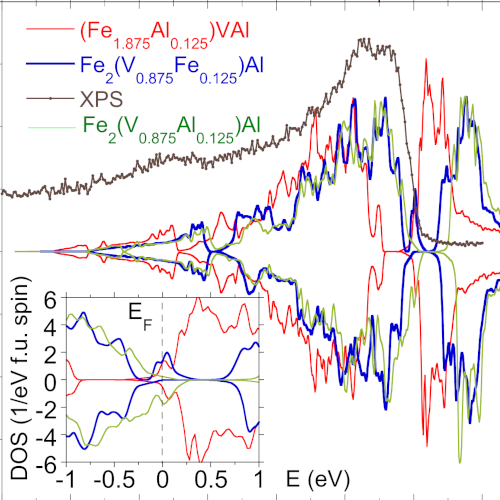 Off-stoichiometric effect on magnetic and electron transport properties of Fe2VAl1.35 in respect to Ni2VAl: Comparative studyAndrzej Ślebarski, Marcin Fijałkowski, Józef Deniszczyk, and 2 more authorsPhys. Rev. B, Apr 2024
Off-stoichiometric effect on magnetic and electron transport properties of Fe2VAl1.35 in respect to Ni2VAl: Comparative studyAndrzej Ślebarski, Marcin Fijałkowski, Józef Deniszczyk, and 2 more authorsPhys. Rev. B, Apr 2024Density functional theory (DFT) calculations confirm that the structurally ordered Fe2VAl Heusler alloy is nonmagnetic narrow-gap semiconductor. This compound is apt to form various disordered modifications with high concentration of antisite defects. We study the effect of structural disorder on the electronic structure, magnetic, and electronic transport properties of the full Heusler alloy Fe2VAl and its off-stoichiometric equivalent Fe2VAl1.35. Data analysis in relation to \it ab initio calculations indicates an appearance of antisite disorder mainly due to Fe–V and Fe–Al stoichiometric variations. The data for weakly magnetic Fe2VAl1.35 are discussed in respect to Ni2VAl. Fe2VAl1.35 can be classified as a nearly ferromagnetic metal with a pronounced spin glassy contribution, which, however, does not give a predominant effect on its thermoelectric properties. The figure of merit ZT is at 300 K about 0.05 for the Fe sample and 0.02 for Ni one, respectively. However, it is documented that the narrow d band resulting from Fe/V site exchange can be responsible for the unusual temperature dependencies of the physical properties of the Fe2TiAl1.35 alloy, characteristic of strongly correlated electron systems. As an example, the magnetic susceptibility of Fe2VAl1.35 exhibits singularity characteristic of a Griffiths phase, appearing as an inhomogeneous electronic state below TG∼200 K. We also performed numerical analysis which supports the Griffiths phase scenario.
@article{slebarski_off_stochiometric_2024, title = {Off-stoichiometric effect on magnetic and electron transport properties of Fe2VAl1.35 in respect to Ni2VAl: Comparative study}, journal = {Phys. Rev. B}, doi = {10.1103/PhysRevB.109.165105}, urldate = {2024-01-04}, publisher = {American Physical Society}, volume = {109}, pages = {165105}, author = {Ślebarski, Andrzej and Fijałkowski, Marcin and Deniszczyk, Józef and Maśka, Maciej M. and Kaczorowski, Dariusz}, month = apr, year = {2024}, keywords = {Condensed Matter - Disordered Systems and Neural Networks,Condensed Matter - Strongly Correlated Electrons}, } -
 Autoencoder-Based Analytic Continuation Method for Strongly Correlated Quantum SystemsMaksymilian Kliczkowski, Lauren Keyes, Sayantan Roy, and 4 more authorsPhys. Rev. B, Sep 2024
Autoencoder-Based Analytic Continuation Method for Strongly Correlated Quantum SystemsMaksymilian Kliczkowski, Lauren Keyes, Sayantan Roy, and 4 more authorsPhys. Rev. B, Sep 2024Solving ill-posed problems is central to a variety of scientific investigations. We focus here on the analytic continuation of imaginary-time data obtained from quantum Monte Carlo (QMC) simulations to the real frequency axis, which involves the numerical inversion of a Laplace transform, a well-known ill-posed problem. We propose an unsupervised autoencoder-type neural network to address this problem, and we show that our encoder-decoder approach can extract high-quality real frequency spectral functions from imaginary-time Green’s functions 𝐺(𝜏). With a deeply tunable architecture we demonstrate, for artificial test data with noise added, that the autoencoder neural network can locate sharp features of spectral functions, which may be lost using maximum entropy (MaxEnt) methods currently in use. We demonstrate the strength of the autoencoder approach by applying it to QMC results for a single-band Hubbard model as a function of density, and we show that it is more robust against noise in the input 𝐺(𝜏) compared to MaxEnt. The proposed method is general and can also be applied to other ill-posed inverse problems.
@article{kliczkowski_autoencod_2024, doi = {10.1103/PhysRevB.110.115119}, journal = {Phys. Rev. B}, publisher = {American Physical Society}, author = {Kliczkowski, Maksymilian and Keyes, Lauren and Roy, Sayantan and Paiva, Thereza and Randeria, Mohit and Trivedi, Nandini and Maska, Maciej M.}, month = sep, year = {2024}, keywords = {Condensed Matter - Disordered Systems and Neural Networks,Condensed Matter - Strongly Correlated Electrons,Physics - Computational Physics}, } -
 Data-driven criteria for quantum correlationsMateusz Krawczyk, Jarosław Pawłowski, Maciej M. Maśka, and 1 more authorPhys. Rev. A, Feb 2024
Data-driven criteria for quantum correlationsMateusz Krawczyk, Jarosław Pawłowski, Maciej M. Maśka, and 1 more authorPhys. Rev. A, Feb 2024We build a machine learning model to detect correlations in a three-qubit system using a neural network trained in an unsupervised manner on randomly generated states. The network is forced to recognize separable states, and correlated states are detected as anomalies. Quite surprisingly, we find that the proposed detector performs much better at distinguishing a weaker form of quantum correlations, namely, the quantum discord, than entanglement. In fact, it has a tendency to grossly overestimate the set of entangled states even at the optimal threshold for entanglement detection, while it underestimates the set of discordant states to a much lesser extent. In order to illustrate the nature of states classified as quantum correlated, we construct a diagram containing various types of states—entangled, as well as separable, both discordant and nondiscordant. We find that the near-zero value of the recognition loss reproduces the shape of the nondiscordant separable states with high accuracy, especially considering the nontrivial shape of this set on the diagram. The network architecture is designed carefully: it preserves separability, and its output is equivariant with respect to qubit permutations. We show that the choice of architecture is important to get the highest detection accuracy, much better than for a baseline model that just utilizes a partial trace operation.
@article{PhysRevA.109.022405, title = {Data-driven criteria for quantum correlations}, author = {Krawczyk, Mateusz and Pawłowski, Jarosław and Maśka, Maciej M. and Roszak, Katarzyna}, journal = {Phys. Rev. A}, volume = {109}, issue = {2}, pages = {022405}, numpages = {12}, year = {2024}, month = feb, publisher = {American Physical Society}, doi = {10.1103/PhysRevA.109.022405}, url = {https://link.aps.org/doi/10.1103/PhysRevA.109.022405}, keywords = {Computer Science - Machine Learning, Quantum Physics} }
2023
-
 Topological phase detection through high-harmonic spectroscopy in extended Su-Schrieffer-Heeger chainsMohit Lal Bera, Jessica O. Almeida, Marlena Dziurawiec, and 5 more authorsPhys. Rev. B, Dec 2023
Topological phase detection through high-harmonic spectroscopy in extended Su-Schrieffer-Heeger chainsMohit Lal Bera, Jessica O. Almeida, Marlena Dziurawiec, and 5 more authorsPhys. Rev. B, Dec 2023Su-Schrieffer-Heeger (SSH) chains are paradigmatic examples of one-dimensional topological insulators hosting zero-energy edge modes when the bulk of the system has a nonzero topological winding invariant. Recently, high-harmonic spectroscopy has been suggested as a tool for detecting the topological phase. Specifically, it has been shown that when the SSH chain is coupled to an external laser field of a frequency much smaller than the band gap, the emitted light at harmonic frequencies strongly differs between the trivial and the topological phase. However, it remains unclear whether various nontrivial topological phases—differing in the number of edge states—can also be distinguished by the high-harmonic generation (HHG). In this paper, we investigate this problem by studying an extended version of the SSH chain with extended-range hoppings, resulting in a topological model with different topological phases. We explicitly show that HHG spectra are a sensitive and suitable tool for distinguishing topological phases when there is more than one topological phase. We also propose a quantitative scheme based on tuning the filling of the system to precisely locate the number of edge modes in each topological phase of this chain.
@article{PhysRevB.108.214104, title = {Topological phase detection through high-harmonic spectroscopy in extended Su-Schrieffer-Heeger chains}, author = {Bera, Mohit Lal and de Almeida, Jessica O. and Dziurawiec, Marlena and P\l{}odzie\ifmmode \acute{n}\else \'{n}\fi{}, Marcin and Ma\ifmmode \acute{s}\else \'{s}\fi{}ka, Maciej M. and Lewenstein, Maciej and Grass, Tobias and Bhattacharya, Utso}, journal = {Phys. Rev. B}, volume = {108}, issue = {21}, pages = {214104}, numpages = {10}, year = {2023}, month = dec, publisher = {American Physical Society}, doi = {10.1103/PhysRevB.108.214104}, } -
 Learning by confusion approach to identification of discontinuous phase transitionsMonika Richter-Laskowska, Marcin Kurpas, and Maciej M. MaśkaPhys. Rev. E, Aug 2023
Learning by confusion approach to identification of discontinuous phase transitionsMonika Richter-Laskowska, Marcin Kurpas, and Maciej M. MaśkaPhys. Rev. E, Aug 2023Recently, the learning by confusion (LbC) approach has been proposed as a machine learning tool to determine the critical temperature \(T_c\) of phase transitions without any prior knowledge of its even approximate value. The method has been proven effective, but it has been used only for continuous phase transitions, where the confusion results only from deliberate incorrect labeling of the data. However, in the case of a discontinuous phase transition, additional confusion can result from the coexistence of different phases. To verify whether the confusion scheme can also be used for discontinuous phase transitions, we apply the LbC method to three microscopic models, the Blume-Capel, the q-state Potts, and the Falicov-Kimball models, which undergo continuous or discontinuous phase transitions depending on model parameters. With the help of a simple model, we predict that the phase coexistence present in discontinuous phase transitions can indeed make the neural network more confused and thus decrease its performance. However, numerical calculations performed for the models mentioned above indicate that other aspects of this kind of phase transition are more important and can render the LbC method even less effective. Nevertheless, we demonstrate that in some cases the same aspects allow us to use the LbC method to identify the order of a phase transition.
@article{PhysRevE.108.024113, title = {Learning by confusion approach to identification of discontinuous phase transitions}, author = {Richter-Laskowska, Monika and Kurpas, Marcin and Maśka, Maciej M.}, journal = {Phys. Rev. E}, volume = {108}, issue = {2}, pages = {024113}, numpages = {14}, year = {2023}, month = aug, publisher = {American Physical Society}, doi = {10.1103/PhysRevE.108.024113}, url = {https://link.aps.org/doi/10.1103/PhysRevE.108.024113}, }
2022
-
 Spin fluctuations and superconductivity in Y5Rh6Sn18 doped with Pd and Co: Evidence of peak effect in the superconducting mixed stateA. Ślebarski, M. Fijałkowski, and M. M. MaśkaPhys. Rev. B, Aug 2022
Spin fluctuations and superconductivity in Y5Rh6Sn18 doped with Pd and Co: Evidence of peak effect in the superconducting mixed stateA. Ślebarski, M. Fijałkowski, and M. M. MaśkaPhys. Rev. B, Aug 2022We performed a systematic study of the nonmagnetic skutterudite-related
Y\(_5\)Rh\(_6\)Sn\(_{18}\) superconductor, where the lattice disorder on the coherence length scale ξ additionally generates a nonhomogeneous, high-temperature superconducting phase with disorder-enhanced critical temperature \(T^*_c\). We have previously discussed various possibilities of local atomic disorder; one of the possibilities is doping. Our present studies focus on the series ofY\(_{5-δ}\)(Rh\(_{5.5}\)M\(_{0.5}\))Sn\(_{18}\) compounds (δ≪1), where the dopants M = Co, Ir, Ru, and Pd, when they are smaller (Co) or larger (Pd) than Rh, generate the peak effect in fields smaller than the critical field \(H_{c2}\). This phenomenon manifests itself as a weak peak in the real and imaginary parts of ac susceptibility and is more distinct in magnetoresistance. Using a simple theoretical model, we demonstrate that the effectiveness of this mechanism depends not only on the magnitude of the difference between the size of the dopant and the host atom, but also on whether the dopant is smaller or larger. The agreement between this prediction and our experimental data strongly supports the impurity-based scenario of the observed peak effect. Magnetoresistance isotherms of the remaining samples (M = Ir and Ru) with the radius of M being very similar to that of Rh show, however, a weak peak-effect-like behavior, which is mainly due to vacancies δ at Y sites, while the corresponding ac susceptibility isotherms exhibit a distinct peak at \(H∼H_{c2}\). This field-dependent χac anomaly appears to be similar in nature to the peak effect; however, it cannot be attributed to pinning and appears to be an equilibrium property of the system. We also report the coexistence of spin fluctuations and superconductivity forY\(_5\)Rh\(_6\)Sn\(_{18}\) doped with Pd and Co.@article{PhysRevB.106.075145, title = {Spin fluctuations and superconductivity in Y<sub>5</sub>Rh<sub>6</sub>Sn<sub>18</sub> doped with Pd and Co: Evidence of peak effect in the superconducting mixed state}, author = {Ślebarski, A. and Fijałkowski, M. and Maśka, M. M.}, journal = {Phys. Rev. B}, volume = {106}, issue = {7}, pages = {075145}, numpages = {15}, year = {2022}, month = aug, publisher = {American Physical Society}, doi = {10.1103/PhysRevB.106.075145}, url = {https://link.aps.org/doi/10.1103/PhysRevB.106.075145}, }
2021
-
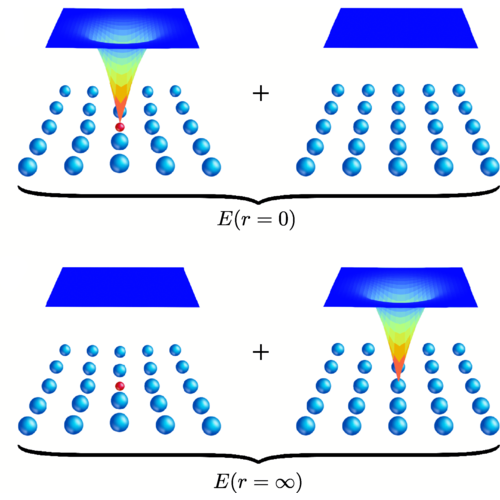 Magnetic field induced reentrance of superconductivity in the cage-type superconductor Y5Rh6Sn18M. Fijałkowski, M. M. Maśka, J. Deniszczyk, and 1 more authorPhys. Rev. B, Oct 2021
Magnetic field induced reentrance of superconductivity in the cage-type superconductor Y5Rh6Sn18M. Fijałkowski, M. M. Maśka, J. Deniszczyk, and 1 more authorPhys. Rev. B, Oct 2021@article{PhysRevB.104.165306, title = {Magnetic field induced reentrance of superconductivity in the cage-type superconductor Y<sub>5</sub>Rh<sub>6</sub>Sn<sub>18</sub>}, author = {Fijałkowski, M. and Maśka, M. M. and Deniszczyk, J. and Ślebarski, A.}, journal = {Phys. Rev. B}, volume = {104}, issue = {16}, pages = {165306}, numpages = {17}, year = {2021}, month = oct, publisher = {American Physical Society}, doi = {10.1103/PhysRevB.104.165306}, url = {https://link.aps.org/doi/10.1103/PhysRevB.104.165306}, } -
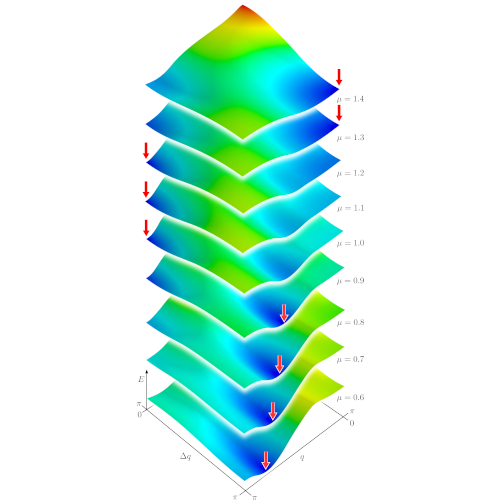 Unconventional topological transitions in a self-organized magnetic ladderMaciej M. Maśka, Nicholas Sedlmayr, Aksel Kobiałka, and 1 more authorPhys. Rev. B, Jun 2021
Unconventional topological transitions in a self-organized magnetic ladderMaciej M. Maśka, Nicholas Sedlmayr, Aksel Kobiałka, and 1 more authorPhys. Rev. B, Jun 2021It is commonly assumed that topological phase transitions in topological superconductors are accompanied by a closing of the topological gap or a change of the symmetry of the system. We demonstrate that an unconventional topological phase transition with neither gap closing nor a change of symmetry is possible. We consider a nanoscopic length ladder of atoms on a superconducting substrate, comprising self-organized magnetic moments coupled to itinerant electrons. For a range of conditions, the ground state of such a system prefers helical magnetic textures, a self-sustaining topologically nontrivial phase. Abrupt changes in the magnetic order as a function of induced superconducting pairing or chemical potential can cause topological phase transitions without closing the topological gap. Furthermore, the ground state prefers either parallel or antiparallel configurations along the rungs, and the antiparallel configuration causes an emergent time reversal asymmetry protecting Kramers pairs of Majorana zero modes, but in a BDI topological superconductor. We determine the topological invariant and inspect the boundary Majorana zero modes.
@article{PhysRevB.103.235419, title = {Unconventional topological transitions in a self-organized magnetic ladder}, author = {Maśka, Maciej M. and Sedlmayr, Nicholas and Kobiałka, Aksel and Domański, Tadeusz}, journal = {Phys. Rev. B}, volume = {103}, issue = {23}, pages = {235419}, numpages = {10}, year = {2021}, month = jun, publisher = {American Physical Society}, doi = {10.1103/PhysRevB.103.235419}, url = {https://link.aps.org/doi/10.1103/PhysRevB.103.235419}, } -
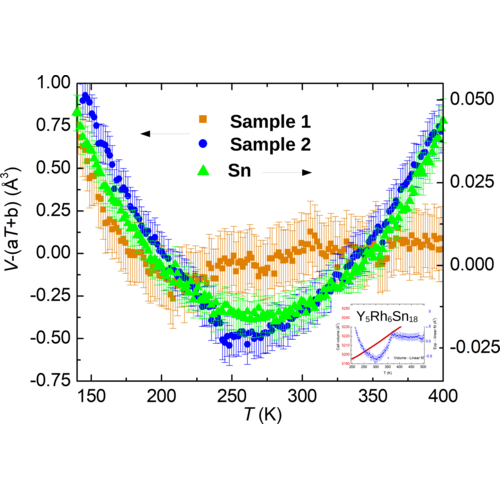 Enhancing superconductivity of Lu5Rh6Sn18 by atomic disorderA. Ślebarski, M. Fijałkowski, M. M. Maśka, and 4 more authorsPhys. Rev. B, Apr 2021
Enhancing superconductivity of Lu5Rh6Sn18 by atomic disorderA. Ślebarski, M. Fijałkowski, M. M. Maśka, and 4 more authorsPhys. Rev. B, Apr 2021@article{PhysRevB.103.155133, title = {Enhancing superconductivity of Lu<sub>5</sub>Rh<sub>6</sub>Sn<sub>18</sub> by atomic disorder}, author = {Ślebarski, A. and Fijałkowski, M. and Maśka, M. M. and Deniszczyk, J. and Zajdel, P. and Trump, B. and Yakovenko, A.}, journal = {Phys. Rev. B}, volume = {103}, issue = {15}, pages = {155133}, numpages = {16}, year = {2021}, month = apr, publisher = {American Physical Society}, doi = {10.1103/PhysRevB.103.155133}, url = {https://link.aps.org/doi/10.1103/PhysRevB.103.155133}, }
2020
-
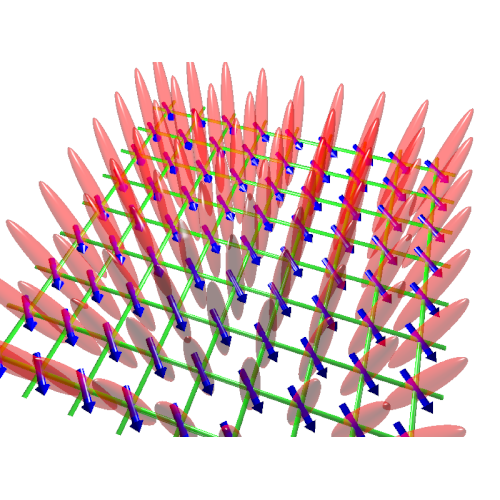 Temperature-driven BCS-BEC crossover and Cooper-paired metallic phase in coupled boson-fermion systemsMaciej M. Maśka, and Nandini TrivediPhys. Rev. B, Oct 2020
Temperature-driven BCS-BEC crossover and Cooper-paired metallic phase in coupled boson-fermion systemsMaciej M. Maśka, and Nandini TrivediPhys. Rev. B, Oct 2020Motivated by strongly correlated and frustrated systems, we propose an effective model that describes the dynamics of pairs of opposite spin fermions scattering from localized bosons. Integrating out one of the degrees, either the bosons or fermions, generates temperature-dependent long-range effective interactions between the entities that we investigate using Monte Carlo techniques. The behavior of bosons is dominated by vortex-antivortex unbinding, with effective interboson interactions beyond the nearest-neighbor Josephson coupling of phases. Remarkably, in the fermion sector we observe a temperature-driven phase transition from a SC phase with a “BCS” spectral function that shows a gap minimum on the underlying Fermi surface to a conducting phase of pairs but with a “BEC” spectral function with a gap minimum at k=0. Tunneling and angle-resolved photoemission spectroscopy on Bose-Fermi mixtures in cold atomic systems and superconducting islands on graphene are some of the promising experimental platforms to test our predictions.
@article{PhysRevB.102.144506, title = {Temperature-driven BCS-BEC crossover and Cooper-paired metallic phase in coupled boson-fermion systems}, author = {Maśka, Maciej M. and Trivedi, Nandini}, journal = {Phys. Rev. B}, volume = {102}, issue = {14}, pages = {144506}, numpages = {10}, year = {2020}, month = oct, publisher = {American Physical Society}, doi = {10.1103/PhysRevB.102.144506}, url = {https://link.aps.org/doi/10.1103/PhysRevB.102.144506}, } -
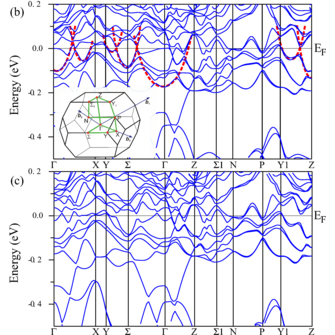 Enhancing superconductivity of Y5Rh6Sn18 by atomic disorderA. Ślebarski, M. Fijałkowski, P. Zajdel, and 6 more authorsPhys. Rev. B, Aug 2020
Enhancing superconductivity of Y5Rh6Sn18 by atomic disorderA. Ślebarski, M. Fijałkowski, P. Zajdel, and 6 more authorsPhys. Rev. B, Aug 2020We investigate the effect of enhancement of superconducting transition temperature Tc by nonmagnetic atom disorder in the filled skutterudite-related tetragonal Y5Rh6Sn18 compound doped with Ca. We documented experimentally that Y5Rh6Sn18 and its Ca-doped alloys are electronically inhomogeneous at the nanoscale, when Ca content is smaller than ∼1.5 in the Y5−xCaxRh6Sn18 system, while for x ≥ 1.5 much stronger chemical phase inhomogeneity is observed with an about 20% volume fraction of the second 3:4:13 cubic phase, which we interpret as a fluctuation of stoichiometry within the bulk sample. Then the enhancement of Tc vs x could be modeled by a mechanism proposed in recent theoretical reports for increasing the mean-field transition temperature Tc in the presence of nonmagnetic disorder. The increase in disorder with doping increases the sample inhomogeneity and causes a systematic increase in Tc , while for two-phase x ≥ 1.5 samples the critical temperature Tc* ≈ 2 × Tc rapidly increases. Based on band structure calculations performed under pressure, we demonstrate how the change in density of states would affect Tc of Y5Rh6Sn18. We obtained the Grüneisen parameter γG larger for the inhomogeneous phase with respect to γG of the bulk Tc phase and attribute the enhancement of Tc to larger stiffening of the high-temperature Tc* phase.
@article{PhysRevB.102.054514, title = {Enhancing superconductivity of Y<sub>5</sub>Rh<sub>6</sub>Sn<sub>18</sub> by atomic disorder}, author = {Ślebarski, A. and Fijałkowski, M. and Zajdel, P. and Maśka, M. M. and Deniszczyk, J. and Zubko, M. and Pavlosiuk, O. and Sasmal, K. and Maple, M. B.}, journal = {Phys. Rev. B}, volume = {102}, issue = {5}, pages = {054514}, numpages = {14}, year = {2020}, month = aug, publisher = {American Physical Society}, doi = {10.1103/PhysRevB.102.054514}, url = {https://link.aps.org/doi/10.1103/PhysRevB.102.054514}, } -
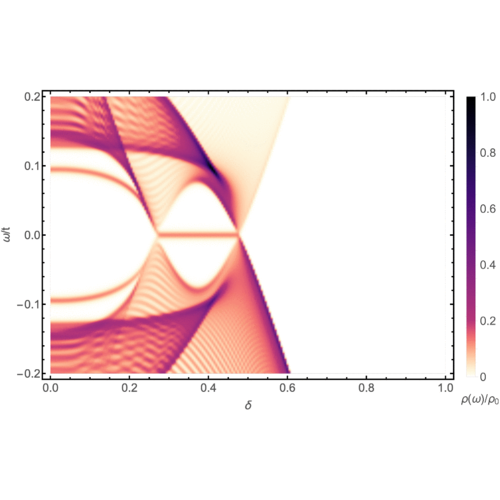 Dimerization-induced topological superconductivity in a Rashba nanowireAksel Kobiałka, Nicholas Sedlmayr, Maciej M. Maśka, and 1 more authorPhys. Rev. B, Feb 2020
Dimerization-induced topological superconductivity in a Rashba nanowireAksel Kobiałka, Nicholas Sedlmayr, Maciej M. Maśka, and 1 more authorPhys. Rev. B, Feb 2020We analyze the influence of dimerization on the topological phases of a Rashba nanowire proximitized to a superconducting substrate. We find that periodic alternations of the hopping integral and spin-orbit coupling can lead to band inversion, inducing a transition to the topologically nontrivial superconducting phase that hosts Majorana zero-energy modes. This “dimerization-induced topological superconductivity” completely repels the topological phase of the uniform nanowire, whenever they happen to overlap. We provide an analytical justification for this puzzling behavior based on symmetry and parity considerations, and discuss feasible spectroscopic methods for its observation. We also test stability of the topological superconducting phases against electrostatic disorder.
@article{PhysRevB.101.085402, title = {Dimerization-induced topological superconductivity in a Rashba nanowire}, author = {Kobiałka, Aksel and Sedlmayr, Nicholas and Maśka, Maciej M. and Domański, Tadeusz}, journal = {Phys. Rev. B}, volume = {101}, issue = {8}, pages = {085402}, numpages = {8}, year = {2020}, month = feb, publisher = {American Physical Society}, doi = {10.1103/PhysRevB.101.085402}, url = {https://link.aps.org/doi/10.1103/PhysRevB.101.085402}, } -
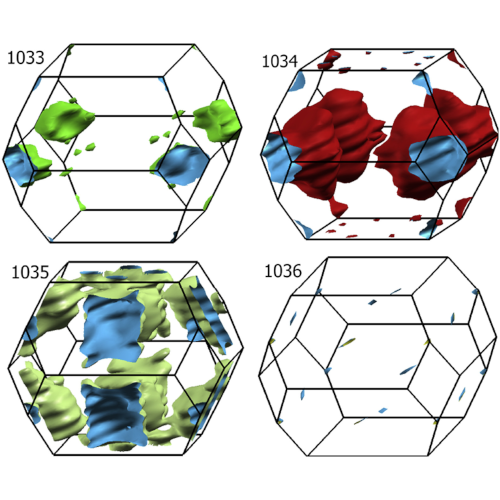 Superconductivity of Y5Rh6Sn18; Coexistence of the high temperature thermal lattice relaxation process and superconductivityA. Ślebarski, P. Zajdel, M.M. Maśka, and 2 more authorsJournal of Alloys and Compounds, Feb 2020
Superconductivity of Y5Rh6Sn18; Coexistence of the high temperature thermal lattice relaxation process and superconductivityA. Ślebarski, P. Zajdel, M.M. Maśka, and 2 more authorsJournal of Alloys and Compounds, Feb 2020The heat capacity, magnetic, and electrical transport properties of skutterudite-related Y5Rh6Sn18 compound indicate intriguing coexistence of the high temperature thermal lattice relaxation process at temperatures higher than 350 K and superconductivity below the superconducting transition temperature Tc=3.08 K. Y5Rh6Sn18, having a cage-like structure crystallises in tetragonal structure with the space group I41/acd. The gap structure of this compound is found not to be characteristic of conventional BCS type superconductors. Anomalous behaviour observed in the electronic specific heat C(T)/T and the upper critical field Hc2(T) data may suggest the presence of two superconducting gaps in this compound. The ab initio band structure calculations showed a significant contribution of s and p Sn states as well as Rh and Y d-electron states to the total density of states near the Fermi level, which supports the multi-band superconductivity of this compound. Several electronic quantities and parameters characterising the superconducting and normal state of Y5Rh6Sn18 are calculated within the Ginzburg-Landau-Abrikosov-Gorkov theory. The data reveals dirty limit superconductivity in Y5Rh6Sn18 superconductor of type-II.
@article{SLEBARSKI2020152959, title = {Superconductivity of Y5Rh6Sn18; Coexistence of the high temperature thermal lattice relaxation process and superconductivity}, journal = {Journal of Alloys and Compounds}, volume = {819}, pages = {152959}, year = {2020}, issn = {0925-8388}, doi = {https://doi.org/10.1016/j.jallcom.2019.152959}, url = {https://www.sciencedirect.com/science/article/pii/S0925838819342057}, author = {Ślebarski, A. and Zajdel, P. and Maśka, M.M. and Deniszczyk, J. and Fijałkowski, M.}, keywords = {Rare earth alloys and compounds, Electronic band structure, Superconductivity, Atomic disorder}, } -
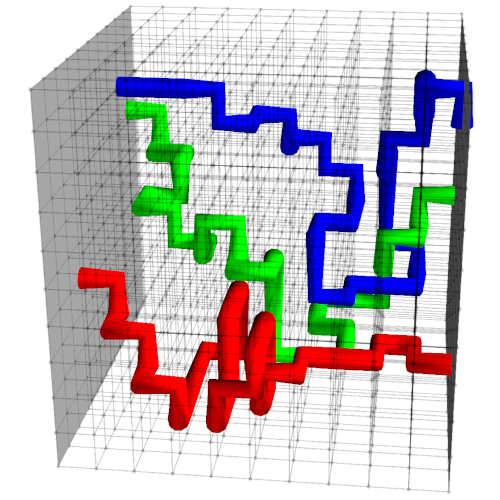 Enhancing Superconductivity of the Nonmagnetic Quasiskutterudites by Atomic DisorderAndrzej Ślebarski, and Maciej M. MaśkaMaterials, Feb 2020
Enhancing Superconductivity of the Nonmagnetic Quasiskutterudites by Atomic DisorderAndrzej Ślebarski, and Maciej M. MaśkaMaterials, Feb 2020We investigated the effect of enhancement of superconducting transition temperature Tc by nonmagnetic atom disorder in the series of filled skutterudite-related compounds (La3M4Sn13, Ca3Rh4Sn13, Y5Rh6Sn18, Lu5Rh6Sn18; M= Co, Ru, Rh), where the atomic disorder is generated by various defects or doping. We have shown that the disorder on the coherence length scale ξ in these nonmagnetic quasiskutterudite superconductors additionally generates a non-homogeneous, high-temperature superconducting phase with Tc⋆>Tc (dilute disorder scenario), while the strong fluctuations of stoichiometry due to increasing doping can rapidly increase the superconducting transition temperature of the sample even to the value of Tc⋆∼2Tc (dense disorder leading to strong inhomogeneity). This phenomenon seems to be characteristic of high-temperature superconductors and superconducting heavy fermions, and recently have received renewed attention. We experimentally documented the stronger lattice stiffening of the inhomogeneous superconducting phase Tc⋆ in respect to the bulk Tc one and proposed a model that explains the Tc⋆>Tc behavior in the series of nonmagnetic skutterudite-related compounds.
@article{ma13245830, author = {Ślebarski, Andrzej and Maśka, Maciej M.}, title = {Enhancing Superconductivity of the Nonmagnetic Quasiskutterudites by Atomic Disorder}, journal = {Materials}, volume = {13}, year = {2020}, number = {24}, article-number = {5830}, url = {https://www.mdpi.com/1996-1944/13/24/5830}, pubmedid = {33371360}, issn = {1996-1944}, doi = {10.3390/ma13245830}, }
2019
-
 Topological superconductivity at finite temperatures in proximitized magnetic nanowiresAnna Gorczyca-Goraj, Tadeusz Domański, and Maciej M. MaśkaPhys. Rev. B, Jun 2019
Topological superconductivity at finite temperatures in proximitized magnetic nanowiresAnna Gorczyca-Goraj, Tadeusz Domański, and Maciej M. MaśkaPhys. Rev. B, Jun 2019Performing Monte Carlo simulations, we study the temperature-dependent self-organization of magnetic moments coupled to itinerant electrons in a finite-size one-dimensional nanostructure proximitized to a superconducting reservoir. At low temperatures, an effective interaction between the localized magnetic moments, that is mediated by itinerant electrons, leads to their helical ordering. This ordering, in turn, affects the itinerant electrons, inducing the topologically nontrivial superconducting phase that hosts the Majorana modes. In a wide range of system parameters, the spatial periodicity of a spiral order that minimizes the ground-state energy turns out to promote the topological phase. We determine the correlation length of such spiral order and study how it is reduced by thermal fluctuations. This reduction is accompanied by suppression of the topological gap (which separates the zero-energy mode from continuum), setting the upper (critical) temperature for the existence of the Majorana quasiparticles. Monte Carlo simulations do not rely on any ansatz for configurations of the localized moments, therefore, they can be performed for arbitrary model parameters, also beyond the perturbative regime.
@article{PhysRevB.99.235430, title = {Topological superconductivity at finite temperatures in proximitized magnetic nanowires}, author = {Gorczyca-Goraj, Anna and Domański, Tadeusz and Maśka, Maciej M.}, journal = {Phys. Rev. B}, volume = {99}, issue = {23}, pages = {235430}, numpages = {16}, year = {2019}, month = jun, publisher = {American Physical Society}, doi = {10.1103/PhysRevB.99.235430}, url = {https://link.aps.org/doi/10.1103/PhysRevB.99.235430}, }
2018
-
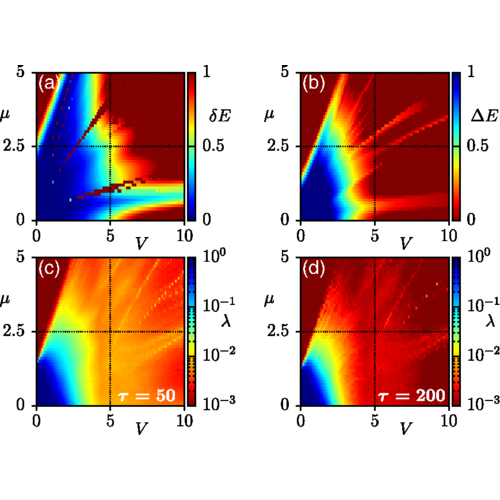 Identification of Majorana Modes in Interacting Systems by Local Integrals of MotionAndrzej Więckowski, Maciej M. Maśka, and Marcin MierzejewskiPhys. Rev. Lett., Jan 2018
Identification of Majorana Modes in Interacting Systems by Local Integrals of MotionAndrzej Więckowski, Maciej M. Maśka, and Marcin MierzejewskiPhys. Rev. Lett., Jan 2018Recently, there has been substantial progress in methods of identifying local integrals of motion in interacting integrable models or in systems with many-body localization. We show that one of these approaches can be utilized for constructing local, conserved, Majorana fermions in systems with an arbitrary many-body interaction. As a test case, we first investigate a noninteracting Kitaev model and demonstrate that this approach perfectly reproduces the standard results. Then, we discuss how the many-body interactions influence the spatial structure and the lifetime of the Majorana modes. Finally, we determine the regime for which the information stored in the Majorana correlators is also retained for arbitrarily long times at high temperatures. We show that it is included in the regime with topologically protected soft Majorana modes, but in some cases is significantly smaller.
@article{PhysRevLett.120.040504, title = {Identification of Majorana Modes in Interacting Systems by Local Integrals of Motion}, author = {Więckowski, Andrzej and Maśka, Maciej M. and Mierzejewski, Marcin}, journal = {Phys. Rev. Lett.}, volume = {120}, issue = {4}, pages = {040504}, numpages = {6}, year = {2018}, month = jan, publisher = {American Physical Society}, doi = {10.1103/PhysRevLett.120.040504}, url = {https://link.aps.org/doi/10.1103/PhysRevLett.120.040504}, } -
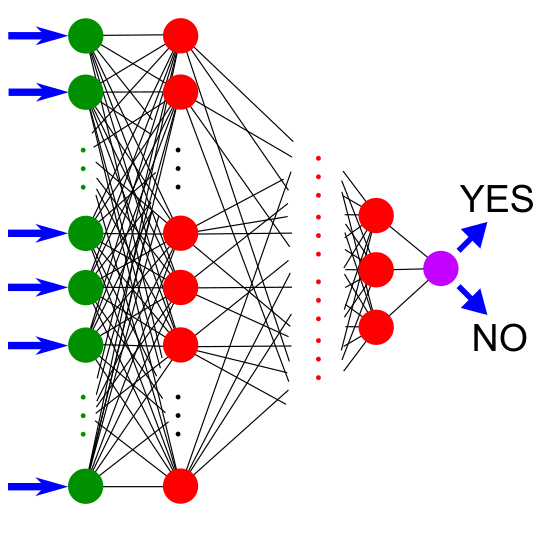 A machine learning approach to the Berezinskii-Kosterlitz-Thouless transition in classical and quantum modelsRichter-Laskowska, Khan, Trivedi, and 1 more authorCondensed Matter Physics, Sep 2018
A machine learning approach to the Berezinskii-Kosterlitz-Thouless transition in classical and quantum modelsRichter-Laskowska, Khan, Trivedi, and 1 more authorCondensed Matter Physics, Sep 2018The Berezinskii-Kosterlitz-Thouless transition is a very specific phase transition where all thermodynamic quantities are smooth. Therefore, it is difficult to determine the critical temperature in a precise way. In this paper we demonstrate how neural networks can be used to perform this task. In particular, we study how the accuracy of the transition identification depends on the way the neural networks are trained. We apply our approach to three different systems: (i) the classical XY model, (ii) the phase-fermion model, where classical and quantum degrees of freedom are coupled and (iii) the quantum XY model.
@article{richter-laskowska_machine_2018, title = {A machine learning approach to the {Berezinskii}-{Kosterlitz}-{Thouless} transition in classical and quantum models}, volume = {21}, issn = {1607324X, 22249079}, doi = {10.5488/CMP.21.33602}, number = {3}, urldate = {2023-09-15}, journal = {Condensed Matter Physics}, author = {{Richter-Laskowska} and {Khan} and {Trivedi} and {Maśka}}, month = sep, year = {2018}, pages = {33602}, } -
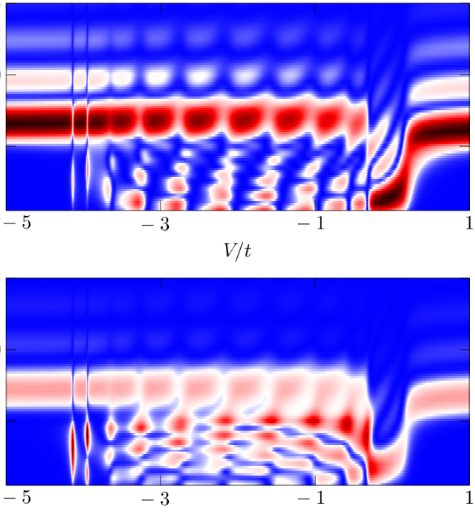 Interplay between pairing and correlations in spin-polarized bound statesSzczepan Głodzik, Aksel Kobiałka, Anna Gorczyca-Goraj, and 4 more authorsBeilstein Journal of Nanotechnology, Sep 2018
Interplay between pairing and correlations in spin-polarized bound statesSzczepan Głodzik, Aksel Kobiałka, Anna Gorczyca-Goraj, and 4 more authorsBeilstein Journal of Nanotechnology, Sep 2018We investigate single and multiple defects embedded in a superconducting host, studying the interplay between the proximity-induced pairing and interactions. We explore the influence of the spin–orbit coupling on energies, polarization and spatial patterns of the bound (Yu–Shiba–Rusinov) states of magnetic impurities in a two-dimensional square lattice. We also address the peculiar bound states in the proximitized Rashba chain, resembling the Majorana quasiparticles, focusing on their magnetic polarization that has been recently reported by S. Jeon et al. (Science 2017, 358, 772). Finally, we study leakage of these polarized Majorana quasiparticles into side-attached nanoscopic regions and confront them with the subgap Kondo effect near to the singlet–doublet phase transition.
@article{Głodzik2018, author = {Głodzik, Szczepan and Kobiałka, Aksel and Gorczyca-Goraj, Anna and Ptok, Andrzej and Górski, Grzegorz and Maśka, Maciej M. and Domański, Tadeusz}, title = {Interplay between pairing and correlations in spin-polarized bound states}, journal = {Beilstein Journal of Nanotechnology}, year = {2018}, volume = {9}, pages = {1370-1380}, issn = {2190-4286}, doi = {10.3762/bjnano.9.129}, copyright = {Głodzik et al.; licensee Beilstein-Institut}, publisher = {Beilstein-Institut}, url = {https://doi.org/10.3762/bjnano.9.129}, keywords = {bound states in superconductors; Majorana quasiparticles; subgap Kondo effect}, }